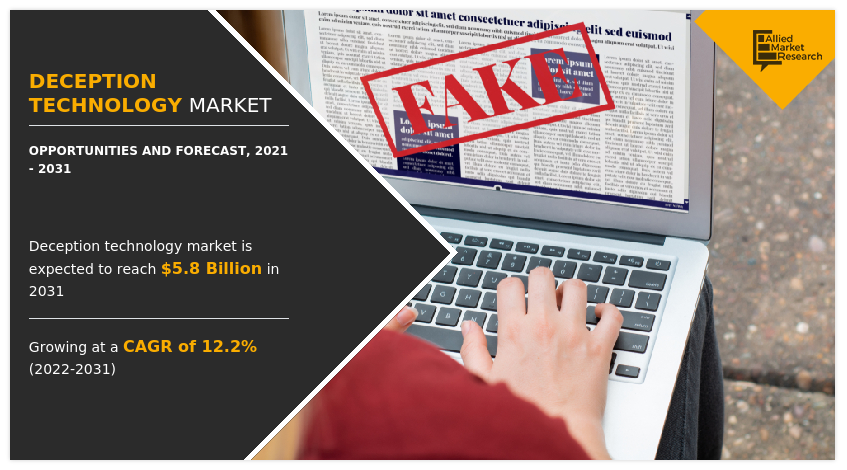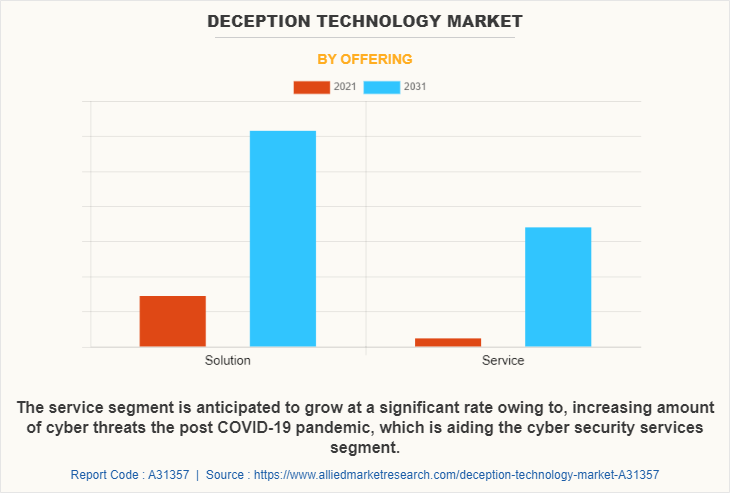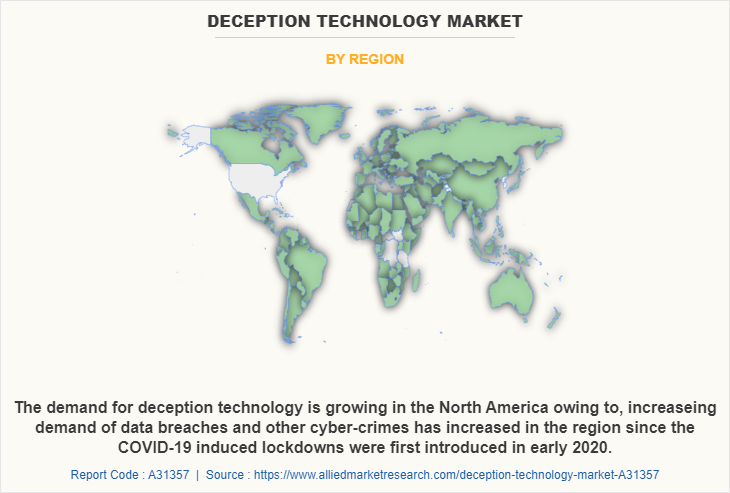Deception Technology Market Insights, 2031
The global deception technology market was valued at USD 1.8 billion in 2021, and is projected to reach USD 5.8 billion by 2031, growing at a CAGR of 12.2% from 2022 to 2031.
Rise of APTs (Advanced persistent threat) and zero-day attacks and need for effective solutions for early detection of attackers is boosting the growth of the global deception technology market. In addition, rise in the adoption of BYOD and IoT trends within enterprises is positively impacts growth of the deception technology market. However, substantial use of legacy honeypots and complexities of device security is hampering the deception technology market growth. On the contrary, integration of deception technology in virtual environments is expected to offer remunerative opportunities for expansion of the deception technology market during the forecast period.

Deception technology is a cybersecurity defense practice that aims to deceive attackers by distributing a collection of traps and decoys across a system's infrastructure to imitate genuine assets. If an intruder triggers a decoy, then the server will log and monitor the attack vectors utilized throughout the duration of the engagement.
The deception technology market is segmented on the basis of offering, deception stack, enterprise size, industry vertical, and region. On the basis of offering, the market is categorized into solution and service. On the basis of deception stack, the market is fragmented into network security, endpoint security, and application security. On the basis of enterprise size, the market is bifurcated into large enterprises and SMEs. By industry vertical, it is classified into BFSI, government and defense, retail and e-commerce, healthcare, IT and telecom, energy and utilities, manufacturing, education, and others. By region, the market is analyzed across North America, Europe, Asia-Pacific, and LAMEA.
The key players that operate in the deception technology market are Allure Security Technology, Inc, Attivo Networks, Inc, Acalvio, CYBERTRAP Software GmbH, CounterCraft, Fidelis Cybersecurity, Guardicore Ltd, Illusive Networks, LogRhythm, Inc, Minerva Labs, PacketViper, Rapid7, Smokescreen Technologies, Inc, TopSpin Security, Trapx Security, vArmour, and WatchGuard Technologies. These players have adopted various strategies to increase their market penetration and strengthen their position in the industry.

In terms of offering, solution segment holds the largest deception technology market share as it assists organizations in detection zero day attacks and predicts any future loopholes. However, the service segment is expected to grow at the highest rate during the forecast period, owing to rise in COVID-19 pandemic, which increased the demand for aiding employees working remotely to access their work network more securely and conveniently.

Region-wise, the deception technology market size was dominated by North America in 2021 and is expected to retain its position during the forecast period, owing to the presence of major players that offer advanced solutions and invest heavily in solutions. However, Asia-Pacific is expected to witness significant growth during the forecast period owing to rise in awareness regarding importance of deception technology among employers adopting cloud service.
Top Impacting Factors
Rise of APTs (Advanced persistent threat) and zero-day attacks
Rise in growth of cyber-attacks including malware and ATPs globally, is driving the growth of the deception technology market. Moreover, the increase in adoption of deception technology across various industries including retail, healthcare, IT, and many more to harden the cloud environment against malware and APTs and to enhance the security services are expected to foster the growth of the deception technology market. In addition, the growing adoption of cyber-security platforms in healthcare sectors to avoid all potential risks and vulnerabilities associated with protected health information is further expected to create massive growth opportunities for the deception technology market over the forecast period.
Furthermore, advanced persistent threat has become one of the most complicated and intractable cyber-attack over the last decade. As APT attacks are conducted through series of actions that comprise social engineering, phishing, command and control servers, and remote desktop control, conventional anti-virus mechanisms become insufficient because they were designed to cope with traditional stand-alone malware attacks. Therefore, increasing APTs is driving the adoption of deception technology among the industries.
Need for effective solutions for early detection of attackers
Deception technology is a category of incident detection and response technology that helps security teams detect, analyze, and defend against advanced threats by enticing attackers to interact with false IT assets deployed within the network. The deception approach can give the end user high-fidelity alerts around specific malicious behaviors, many of which are challenging to identify by log analysis or a SIEM tool alone.
In addition, it can identify suspicious activity early in an attack chain, as well as confuse and misdirect an adversary on internal network, which in turn is a major factor driving the growth of deception technology industry. Furthermore, deception technology is a effective solution to divert malicious traffic away from important systems, identify anomalous network scans, and reveal information about attackers and their methods. Thus, these are the major factors driving the growth of the deception technology industry.
COVID-19 Impact Analysis
The outbreak of COVID-19 is anticipated to have a positive impact on the growth of deception technology market. This is attributed to the fact that with the emergence of COVID-19, the use of deception technology is expected to enable enterprises to address security issues and facilitate secured information access while remote working.
In addition, owing to the increase in internet traffic, the danger of cyber-attacks has grown significantly in numerous enterprises, necessitating the implementation of deception technology solutions. Innovations and advancements in deception technology solutions, such as cloud security and AI-integrated solutions as well as an increase in the number of cyberattacks since the outbreak of the pandemic, have fueled market development. For instance, according to a report from Palo Alto Networks’ Unit 42 security consulting group, the average ransomware payment climbed 82% to a record $570,000 in the first half of 2021 from $312,000 in 2020. Thus, increase in ransomware of cyberattacks augments the demand for deception technology solution & services, thereby fueling the growth of the global market.
Key Benefits For Stakeholders
- This report provides a quantitative analysis of the Deception Technology Market Forecast, current trends, estimations, and dynamics of the deception technology market analysis from 2021 to 2031 to identify the prevailing deception technology market opportunities.
- The market research is offered along with information related to key drivers, restraints, and opportunities.
- Porter's five forces analysis highlights the potency of buyers and suppliers to enable stakeholders make profit-oriented business decisions and strengthen their supplier-buyer network.
- In-depth analysis of the deception technology market segmentation assists to determine the prevailing market opportunities.
- Major countries in each region are mapped according to their revenue contribution to the global market.
- Market player positioning facilitates benchmarking and provides a clear understanding of the present position of the market players.
- The report includes the analysis of the regional as well as global deception technology market trends, key players, market segments, application areas, and market growth strategies.
Deception Technology Market Report Highlights
| Aspects | Details |
| By Offering |
|
| By Deception Stack |
|
| By Enterprise Size |
|
| By Industry Vertical |
|
| By Region |
|
| Key Market Players | Attivo Networks, Inc, Acalvio, Trapx Security, CYBERTRAP Software GmbH, WatchGuard Technologies, Smokescreen Technologies, Inc, Watchguard Technologies, Inc., PacketViper, CounterCraft, Minerva Labs, TopSpin Security, Guardicore Ltd, Illusive Networks, LogRhythm, Inc, Allure Security Technology, Inc, Fidelis Cybersecurity, Rapid7, vArmour |
Analyst Review
Deception technology is a category of simple, effective cybersecurity defenses that detect threats early with low false positives and minimal network performance impact. The technology creates realistic decoy assets such as, domains, databases, active directories, servers, applications, files, credentials, breadcrumbs, and sessions to be deployed in the network alongside real assets to act as lures for cybercriminals. Attackers who breach the network have no way to differentiate the fake from the real, and the moment they interact with a decoy, a silent alarm is raised. Then systems begin collecting information on the attacker's actions & intent, and then use that Intel to generate high-fidelity alerts that decrease dwell time and speed up incident response.
The global deception technology market is expected to register high growth due to rapid centralization and digitization of business processes to streamline all operations into a single platform. Thus, increase in adoption of deception technology, owing to its security is one of the most significant factors driving the growth of the market. With surge in demand for deception technology, various companies have established alliances to increase their capabilities. For instance, in March 2022, Hexagon US Federal partnered with CounterCraft to broaden its cyber security offerings with CounterCraft's unique deception technology, which enables organizations to improve threat detection and response, and provide a comprehensive OT cybersecurity solution for asset visualization, vulnerability/patch management, configuration management, and enterprise resiliency/recovery.
In addition, with further growth in investment across the world and the rise in demand for deception technology, various companies have expanded their current product portfolio with increased diversification among customers. For instance, in July 2021, Attivo Networks®, the leader in identity detection and response, launched Cloud Infrastructure Entitlement Management (CIEM) solution. The IDEntitleX is designed to deliver visibility and reduce the attack surface for identities and entitlements in the cloud. With this new product introduction, Attivo becomes the only solution of its kind to provide end-to-end analysis of identity and entitlement exposures and risks on endpoints, Active Directory (AD), and the cloud.
Moreover, with increase in competition, major market players have started acquisition companies to expand their market penetration and reach. For instance, in September 2021, Akamai Technologies, Inc., the world's most trusted solution for protecting and delivering digital experiences acquired Tel Aviv, Israel-based Guardicore. By adding Guardicore's micro-segmentation solution into Akamai's extensive Zero Trust security portfolio, Akamai will be uniquely suited to provide comprehensive protections to the enterprise, defending against threat actors and the spread of malware and ransomware.
The global deception technology market was valued at $1.84 billion in 2021, and is projected to reach $5.76 billion by 2031
The deception technology market is projected to grow at a compound annual growth rate of 12.2% from 2022 to 2031.
The key players that operate in the deception technology market are Allure Security Technology, Inc, Attivo Networks, Inc, Acalvio, CYBERTRAP Software GmbH, CounterCraft, Fidelis Cybersecurity, Guardicore Ltd, Illusive Networks, LogRhythm, Inc, Minerva Labs, PacketViper, Rapid7, Smokescreen Technologies, Inc, TopSpin Security, Trapx Security, vArmour, and WatchGuard Technologies. These players have adopted various strategies to increase their market penetration and strengthen their position in the industry.
Region-wise, the deception technology market size was dominated by North America in 2021 and is expected to retain its position during the forecast period
Rise of APTs (Advanced persistent threat) and zero-day attacks and need for effective solutions for early detection of attackers is boosting the growth of the global deception technology market.
Loading Table Of Content...



